Chicago has signed defenceman Alex Vlasic to a six-year deal with an AAV of $4.6M per season. I wrote about him yesterday when discussing the Blackhawks so read that for more on him.
In salary cap leagues, this could be fine. It isn't a heavy cap hit and he was just shy of two blocks per game last season. The problem was the 56 hits; if he's a 60- to 70-hit guy with maybe 20-25 points, it is only the blocked shots bringing a lot of value. It isn't a reason to cut him yet but it isn't hard to see this not being a value contract in cap formats.
*
Just want to say rest in peace to Bob Cole. He was the voice of the childhoods of millions of Canadians spanning multiple generations, and is truly one of the greatest sports broadcasters we've ever enjoyed, let alone hockey broadcasters. So many incredible calls over the years – Jeeeeohhh Saaaakic! Condolences to his family and thanks for the memories, Mr. Cole.
*
We may be seeing the end of the one of arguably the best run from a franchise since the 2013 lockout.
Florida beat Tampa Bay 5-3 in Game 3, taking a commanding 3-0 series lead. The Lightning can still come back and pull off the reverse sweep, though that is incredibly unlikely.
Beginning with the 2013-14 season, the Lightning have 86 playoff wins. As of today, that is 30 more than any other franchise (funny enough, it's Vegas in second place with 56). That stretch has seen two Stanley Cup wins, two other Cup Final appearances, and two other Conference Final appearances. In other words, they made at least the Conference Final more often (6) than not (5) over the last 11 seasons. It has been an incredible run, but with the aging core, a free agent Steven Stamkos, and few prospects breaking down the door, this is starting to resemble Chicago in 2018.
Brandon Montour had a goal and an assist with two shots, two blocks, two PIMs, and a hit in a great multi-cat fantasy night. Steven Lorentz also had a goal and an assist (seriously) while Matthew Tkachuk scored twice (one ENG) and Sam Reinhart also got on the board.
Stamkos, Tyler Motte, and Nick Paul replied for the Lightning.
Anton Lundell had an assist with a block and two hits in 17:29 of ice time as he took the place of the injured Sam Bennett.
Game 4 is on the late-afternoon game on Saturday.
*
Carolina also took care of business thanks to their Game 3 win over the New York Islanders by a slim 3-2 margin We have to give it to the Islanders, they've largely kept the games close, even with that epic third-period collapse in Game 2. It will probably end in a sweep and it'll be one where they had a chance to win every game they were in. It isn't much comfort to Islanders fans, but it's something.
With Brett Pesce injured, the defence stepped up in a big way for Carolina as Brent Burns and Dmitry Orlov both scored while Jaccob Slavin, Brady Skjei, and Tony DeAngelo had three shots apiece. Even when the forwards aren't scoring much – and Sebastian Aho did get the team's third goal – they still involve the blue line enough where they can win games for them, too.
One intriguing storyline was Ilya Sorokin getting pulled after Carolina's third goal midway through the second period. He did not look too happy about which, considering who his coach is, is simply delicious.
Brock Nelson and Pierre Engvall had the goals for New York.
Game 4 is the early-afternoon game on Saturday.
*
My offseason series of reviewing the 16 non-playoff teams started this week with San Jose and Chicago. We are working our way up the standings, and the next team on the list is the Anaheim Ducks. Let's look at what went right, what went wrong, and where the team goes from here, all through a fantasy hockey lens.
Data from Natural Stat Trick, Evolving Hockey, HockeyViz, and Frozen Tools with salary cap data from Cap Friendly. Any tracking data is from AllThreeZones unless otherwise noted.
What Went Wrong
We try to gloss over injuries in this section because all teams go through them, but Anaheim was hit hard: according to NHL Injury Viz, the Ducks were 1 of 7 teams to lose at least 300 man games and lost the fourth-most man games among just forwards. A quick list:
- Jamie Drysdale effectively missed 72 games; he was injured for two months, returned briefly and then was traded for a prospect
- Brock McGinn missed 58 games
- Trevor Zegras missed 51 games
- Isac Lundestrom missed 36 games
- Leo Carlsson missed 27 games, though he did get some nights off for rest
- Pavel Mintyukov missed 19 games
- Alex Killorn missed 19 games
- Mason McTavish missed 18 games
- Radko Gudas missed 16 games
That is a handful of players missing anywhere from 30-70% of the season and a handful missing roughly 20-25%. When you're a rebuilding team and half your lineup, including several top-of-the-roster players, averages 35 games missed, well, things are going to look bad. And that doesn't even include Troy Terry playing through a shoulder injury for the final two months of the season.
Given the injuries and how far this team had to come after finishing dead last in 2022-23, there were struggles. They finished 30th by goals-for per 60 minutes, though the gap between them and 31st (0.29 goals) was fairly large, so they were closer to Washington and Seattle than they were San Jose and Chicago. They were also 30th by goals against per 60 minutes, with only San Jose and Columbus ranking worse.
A big problem for the goals against was the penalty kill. They finished 31st in the league by goals against per 60 minutes while short-handed with them and the New York Islanders being over a full goal behind 30th-place Ottawa. What made things especially bad was giving up 4.02 power plays per game to the opponent. Only one team was worse than 3.5, and it was Florida at 3.55. Anaheim gave 13% more power plays than the next-most undisciplined team, and that led to an absurd 87 power play goals against. The next-worst team was Minnesota at 66, and it was the most power play goals allowed since the 2008-09 season. Knowing this, Lukas Dostal posting a .902 overall save percentage feels like a miracle.
The lack of goals hurt almost everyone offensively. Mason McTavish led the team with 2.42 points/60 at all strengths, and that gave them zero forwards in the top-100 of the league by points rate. Anaheim finished the year with a near-identical goals rate to what they did in 2022-23 so it's hard to say there was any improvement in that area.
It was a bad season in net for John Gibson. While we can chalk some of that up to a bad team, looking at his .888 save percentage (44 starts) when Dostal is right there with his .902 (38 starts) kind of highlights Gibson's issues. That is compounded by the fact that Anaheim was better defensively at 5-on-5 in 2023-24 than they were in 2022-23. Here is what the team allowed in front of Gibson last season:

And what they allowed in front of him this season:

Despite that improvement in the defensive play in front of him, Gibson's save percentage at 5-on-5 fell from .913 to .908. That isn't a huge decline in and of itself, but that the team improved by a good margin and he still fell off is not a great sign. He also got obliterated on the penalty kill as his .826 save percentage while short-handed was 25th out of 27 goalies that skated at least 200 minutes on the PK. Some of that is, again, on the team, but again, Dostal was considerably better (.850) so it is tough to say it was all Anaheim.
Outside of Anaheim's penalty kill and Gibson's play, it's hard to say much else went wrong. This was a team that finished last in 2022-23 and lost several key players to injury for lengthy stretches. Saying that Leo Carlsson didn't show much offensively, Trevor Zegras took a step back, or Troy Terry disappointed, in that context, feels misguided.
What Went Right
It is always hard to say a team that finished 30th in the standings had a lot of things go right, but Anaheim had a lot of things go right.
At the top of the list is Mintyukov. He led the team's defencemen with 1.42 points per 60 minutes, a rate that tied him with Drew Doughty and Sean Durzi, edging slightly ahead of names like Brock Faber, Torey Krug, and Moritz Seider. He also got just 7 of his 28 points on the power play, so it wasn't all just special-team work. That he managed 88 shots, 85 hits, and 65 blocks in 63 games shows there is some multi-category upside to his game as well.
It wasn't Mintyukov getting lucky, either. He led the team by even strength expected goals-for play driving and was their only regular blue liner to finish above average. Across the league, he compared very favourably to genuine all-stars:

The ways he achieved that are equally impressive. He led their blue line by exiting the zone with possession 83.3% of the time at 5-on-5, and that's on a team that averaged 69.5% (league average of 62.6%). He also failed to exit the zone just 21.1% of the time where the team average was 28.6% and the league average was 26.1%. When looking for defencemen that exited the zone with possession at least 80% of the time and failed to exit the zone less than 22% of the time, the list is very short and very distinguished:

There are just 16 of 63 games tracked from Mintyukov, but even a 16-game sample like this is really, really good.
Have we mentioned he was a 20-year-old rookie? Because he was a 20-year-old rookie.
That same tracking data shows Mintyukov with 12 scoring chance assists in those 16 games, which is the rate he had a helped on an Anaheim scoring chance. No one else in the data from this team had more than seven, and here are his 60-minute comparables across the league:
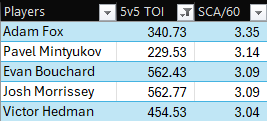
Not bad at all.
Mintyukov also had a zone entry carry-in rate of 52.4% (yes, it led the Ducks' defencemen) against a team average of 37.2%. He was extremely good at getting out of the defensive zone with the puck, getting into the offensive zone with the puck, and then finding his teammates for scoring chances. As a 20-year-old rookie, it is almost unfathomable.
Of course, there were defensive issues, but even still, he denied the blue line to the opponent on 15.1% of entries against a team average of 8.4%. Even with some in-zone issues that are often apparent for young, rookie defencemen, he still showed some good signs on the defensive side of the puck.
It is hard not to get excited about Mintyukov, but the complication for fantasy hockey is Olen Zellweger. He was a rookie as well and got some serious top power play run late in the season. It is very hard to say who will get top billing in 2024-25, and those top PP minutes are vital to the fantasy value of any point-producing defenceman, especially where even a sizable improvement in Anaheim's 5-on-5 scoring would still have them in the bottom-third of the league again next year.
Despite some struggles scoring through most of the roster, it was a great year for Frank Vatrano. His 37 goals were a career high, and not far behind what he did in the previous two seasons combined (40). It was a bit of an inconsistent one, which likely frustrated head-to-head managers, but we can't be too mad about a 37-goal season.
That Vatrano had 272 shots, 156 hits, 85 penalty minutes, and 20 power play points really helped round out an excellent multi-cat effort. His 13.6% shooting was a career-high, but he had surpassed 11% in three different seasons so it's nothing wildly out of line. Also, with Anaheim moving from 30th by shots off the rush at 5-on-5 to 23rd, and their improved focus on controlled entries and exits, maybe he can sustain close to 12-13% again next season and threaten 35 goals.
It was hard not to be impressed with Leo Carlsson. The second overall pick in 2023 played 55 games, was given some nights off as they had a workload plan for him, but also missed a couple weeks due to a concussion. He still had 29 points in those 55 games while leading their centres with 15:40 per game in even strength ice time. With injuries elsewhere in the lineup, he often saw shutdown matchups and still finished second on the team in expected goal share at 5-on-5 with good impacts at both ends:
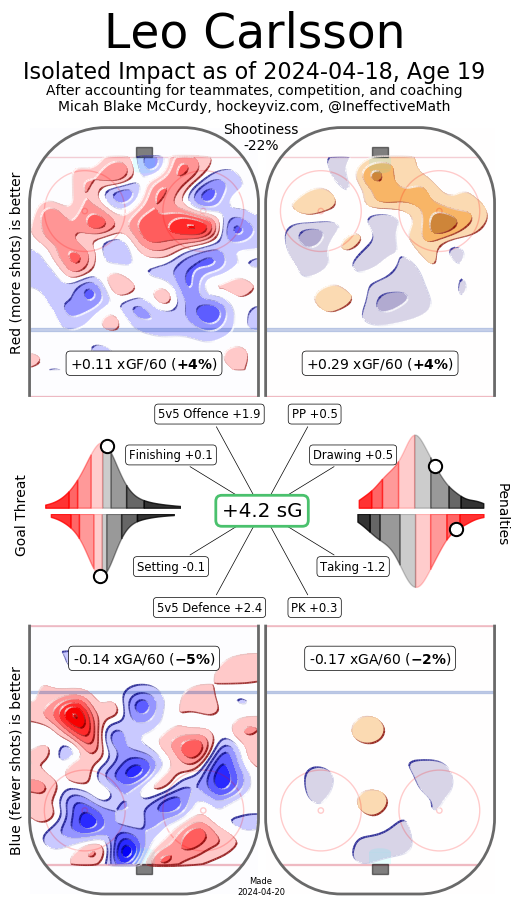
Not only that, but like Mintyukov, it was an excellent season in transition. It isn't a huge sample of games tracked yet, but here are Carlsson's comparable players by workload of zone entries, and percentage of entries that are carried or passed in:

This is an exciting young player who looks like he'll be a productive fantasy option sooner rather than later.
Where They Go From Here
What sets this team apart from Chicago and San Jose below them is they don't really need Macklin Celebrini to accelerate the rebuild: both Mintyukov and Carlsson looked great in their rookie seasons, Cutter Gauthier's college career is over and he'll be in Anaheim next season, Zellweger showed the offensive upside they're hoping for, Mason McTavish led the team in points per 60 minutes, and Dostal was solid in net. Terry didn't have the season he was expected to have but still had a lot of good playmaking/transition stats, Vatrano is a proven goal scorer, and Zegras can be potent offensively if he's healthy. There are reliable veterans like Alex Killorn and Radko Gudas around for at least two more seasons, and some younger guys with upside like Tristan Luneau and Sam Colangelo. This team has a good mix of older veterans, proven players in their prime, and a bevy of young, high-end skaters. On top of all that, they still have a decent shot at drafting Celebrini and even if they don't, they'll get a very good pick at the top of a draft that is deep for 10 picks after Celebrini. All the pieces are there for this team to really start making a charge in 2024-25. They likely won't be a playoff team, but they'll be closer to that than they will the basement, and their offence should improve a lot with all that talent and (hopefully) better health luck.
That is what makes 2024 a very interesting offseason for them. They have two first-round picks (theirs and Edmonton's), they have two second-round picks, and three third-round picks. They also have just a few unrestricted free agents and it seems like none of them will return. Their restricted free agents are not franchise pillars, so maybe they spend around $10M AAV bringing back guys like Lundestrom, Max Jones, and Jackson LaCombe.
Depending on the combined AAVs of those RFAs, Anaheim could have anywhere from $20M-$25M in cap space to spend this offseason with all of Zegras, Gauthier, Carlsson, Mintyukov, and Zellweger not needing new contracts until 2026-27. They have the draft picks and prospects to make a big splash in the trade market for a young-ish RFA like Casey Mittelstadt, Martin Necas, or Sean Durzi, and the cap space to sign them.
No matter what they do this summer, Anaheim is well-positioned to really take a step forward in 2024-25, both for fantasy relevance and in the standings. However, they are one lucky Lottery pick away from really stepping on the gas pedal, and that makes the next 10 weeks the most critical for this franchise in several years.
One Comment
Leave A Comment
You must be logged in to post a comment.

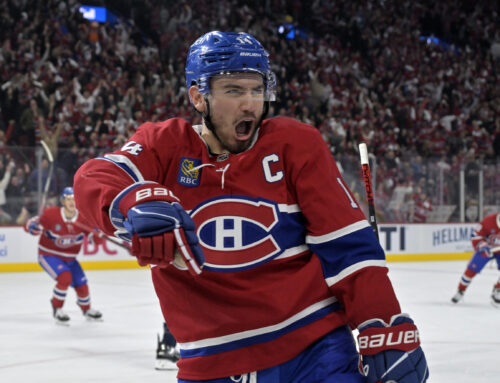
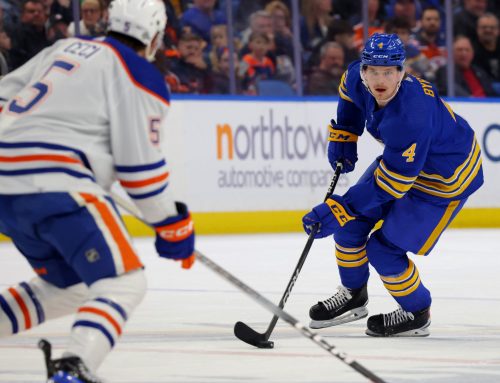
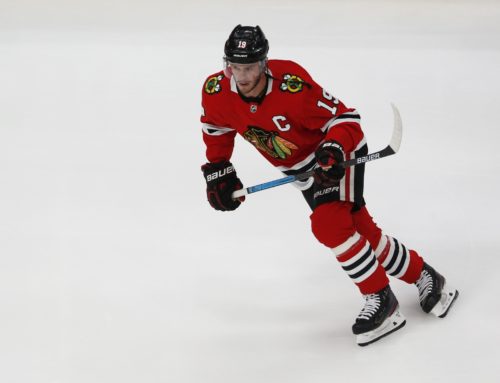
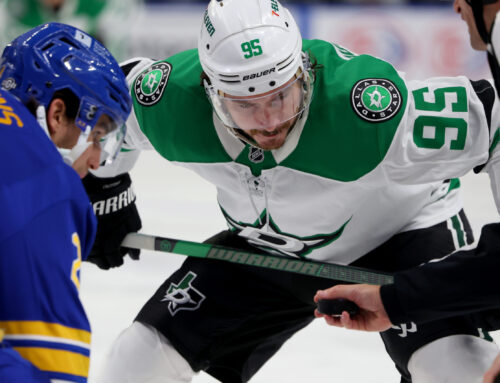
 CHI
CHI SEA
SEA FLA
FLA DAL
DAL WPG
WPG CBJ
CBJ L.A
L.A MIN
MIN DET
DET VAN
VAN

Dare I say Dostal was a pleasant surprise. His stats were modest at best, but he certainly looks like the future for Ducks if they can rid themselves of Gibson.